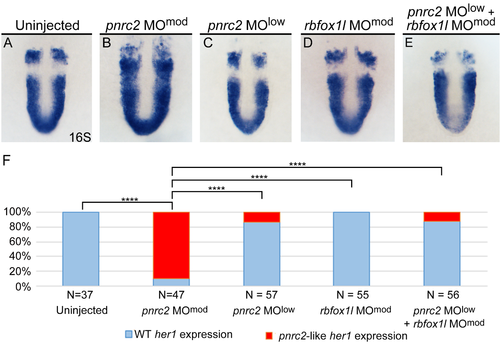Fig. S3
- ID
- ZDB-FIG-170921-60
- Publication
- Gallagher et al., 2017 - Pnrc2 regulates 3'UTR-mediated decay of segmentation clock-associated transcripts during zebrafish segmentation
- Other Figures
- All Figure Page
- Back to All Figure Page
|
her1 expression is normal in embryos injected with a control MO, either alone or in combination with a sub-optimal dose of pnrc2 sbMO. Injection of a sub-optimal dose of pnrc2 sbMO (2 ng) has little to no effect on her1 expression (A, C), contrasting with the expected her1 misexpression observed after injection of a moderate dose of pnrc2 sbMO (6 ng) (B). Injection of a moderate dose of an unrelated sbMO targeting rbfox1l (6 ng) either alone (D) or combined with a sub-optimal dose of pnrc2 sbMO (2 ng) has no effect on her1 expression (E). The proportion affected in each condition is plotted on a bar graph that indicates significant differences between single morphants, double morphants, and controls (F). To confirm effective rbfox1l knockdown, we co-injected rbfox1l and rbfox2 sbMOs (6 ng each) in parallel experiments (neither sbMO produces an overt morphological phenotype when injected alone) and observed the expected paralysis phenotype in all double-injected embryos (n=27/27 paralyzed embryos at 24 hpf) (Gallagher et al, 2011; Berberoglu et al, 2017), confirming that we were using an effective rbfoxl1 sbMO dose in our experiments. sbMO = splice-blocking MO; **** = p<0.0001. |
Reprinted from Developmental Biology, 429(1), Gallagher, T.L., Tietz, K.T., Morrow, Z.T., McCammon, J.M., Goldrich, M.L., Derr, N.L., Amacher, S.L., Pnrc2 regulates 3'UTR-mediated decay of segmentation clock-associated transcripts during zebrafish segmentation, 225-239, Copyright (2017) with permission from Elsevier. Full text @ Dev. Biol.

